MERS-CoV Immunity Not Widespread
By LabMedica International staff writers
Posted on 12 Jun 2014
A study has found no significant rates of antibodies against Middle East respiratory syndrome coronavirus (MERS-CoV) in one Middle East-North Africa (MENA) region, suggesting that the virus has not been circulating in humans for long, and that the majority of the population remains susceptible to infection. The results of the study by Aburizaiza et al., was published in the January 2014 issue of the Journal of Infectious Diseases, (Vol. 20 (2)). Posted on 12 Jun 2014
The study involved 130 blood donors and 226 slaughterhouse workers from Jeddah and Makkah (Saudi Arabia) sampled during 2012. Serum samples were analyzed using the recommended staged serological approach: screening of IgG and IgM antibodies by conventional IFA based on MERS-CoV-infected and non-infected cells (EUROIMMUN AG; Lübeck, Germany), followed up by confirmation by discriminative recombinant IFA based on viral spike proteins and plaque-reduction neutralization assay. Only eight sera were positive in the screening test, and these reactions were subsequently resolved to be specific for established coronaviruses. These results highlight the importance of multistage serological testing. Nevertheless, the level of cross reactivity with other human coronaviruses in the screening test is relatively low. Significantly, these results demonstrate an absence of population immunity in the region and at the sampling timepoint.

Image: MERS-CoV electron micrograph: MERS-CoV particles as seen by negative stain electron microscopy. Virions contain characteristic club-like projections emanating from the viral membrane (Photo courtesy of Wikipedia Commons).
MERS-CoV is an emerging pathogen which is responsible for an outbreak of severe acute respiratory illness predominantly in the Arabian Peninsula with a high number of fatalities. From September 2012 to March 2014, there have been 206 laboratory-confirmed cases with 86 deaths. The transmission mechanisms of the virus remain unknown, and animal reservoirs are suspected to play a role. In a further serological study, antibodies against MERS-CoV were detected in a majority of dromedary camels sampled in the United Arab Emirates in 2003 and 2013 (Meyer et al., Emerging Infectious Diseases, Vol. 20 (4), April 2014). The high antibody prevalence suggests a potential role for camelids in the emergence and spread of the virus in humans.
Related Links:
WHO
EUROIMMUN AG













